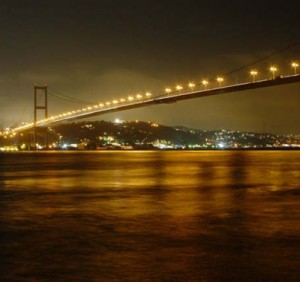 Istanbul is the only city in the world that spans over two continents. Europe and Asia. The city embodies mystery, intrigue, and glamour which left most other cities long ago. While the museums, palaces, great mosques, and bazaars seem inexhaustible, there’s also an unexpected natural beauty. From the shores of the Bosphorus at sunset, the red evening light reflects in the windows on the opposite shore and you understand what attracts people to this glorious city.
Istanbul is the only city in the world that spans over two continents. Europe and Asia. The city embodies mystery, intrigue, and glamour which left most other cities long ago. While the museums, palaces, great mosques, and bazaars seem inexhaustible, there’s also an unexpected natural beauty. From the shores of the Bosphorus at sunset, the red evening light reflects in the windows on the opposite shore and you understand what attracts people to this glorious city.
St. Sophia
 The Church of the Holy Wisdom, known as Hagia Sophia in Greek, Sancta Sophia in Latin, and Ayasofya or Aya Sofya in Turkish, is a former Byzantine church and former Ottoman mosque in Istanbul. Now a museum, Hagia Sophia is universally acknowledged as one of the great buildings of the world.
The Church of the Holy Wisdom, known as Hagia Sophia in Greek, Sancta Sophia in Latin, and Ayasofya or Aya Sofya in Turkish, is a former Byzantine church and former Ottoman mosque in Istanbul. Now a museum, Hagia Sophia is universally acknowledged as one of the great buildings of the world.
Unfortunately nothing remains of the original Hagia Sophia, which was built on this site in the fourth century by Constantine the Great. Constantine was the first Christian emperor and the founder of the city of Constantinople, which he called “the New Rome.”
Basilica Cittern
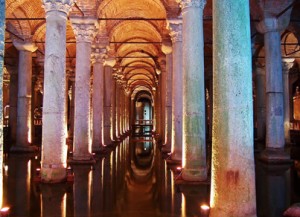 The Basilica Cistern, located in the crowded Eminönü district of Istanbul next to the Hagia Sophia, was built to provide water for the city of Istanbul during the reign of Emperor Justinian I in the 6th century CE. This cistern is an underground chamber of 138 x 64.6 metres. The large space is broken up by a forest of 336 marble columns. The ceiling vaults, known as Manastir Tonozu (cloister vault), are built without using a mould. The cistern is surrounded by a firebrick wall with a thickness of 3.5 meters and is coated with a special mortar to make it waterproof.
The Basilica Cistern, located in the crowded Eminönü district of Istanbul next to the Hagia Sophia, was built to provide water for the city of Istanbul during the reign of Emperor Justinian I in the 6th century CE. This cistern is an underground chamber of 138 x 64.6 metres. The large space is broken up by a forest of 336 marble columns. The ceiling vaults, known as Manastir Tonozu (cloister vault), are built without using a mould. The cistern is surrounded by a firebrick wall with a thickness of 3.5 meters and is coated with a special mortar to make it waterproof.
Blue Mosque
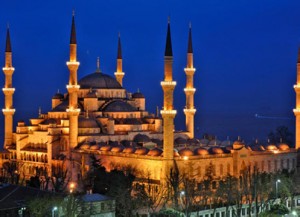 The Blue Mosque was commissioned by Sultan Ahmet I when he was only 19 years old. It was built near the Hagia Sophia, over the site of the ancient hippodrome and Byzantine imperial palace (whose mosaics can be seen in the nearby Mosaic Museum). Construction work began in 1609 and took seven years.
The Blue Mosque was commissioned by Sultan Ahmet I when he was only 19 years old. It was built near the Hagia Sophia, over the site of the ancient hippodrome and Byzantine imperial palace (whose mosaics can be seen in the nearby Mosaic Museum). Construction work began in 1609 and took seven years.
The mosque was designed by architect Mehmet Aga, whose unfortunate predecessor was found wanting and executed. Sultan Ahmet was so anxious for his magnificent creation to be completed that he often assisted in the work. Sadly, he died just a year after the completion of his masterpiece, at the age of 27.
Maiden’s Tower
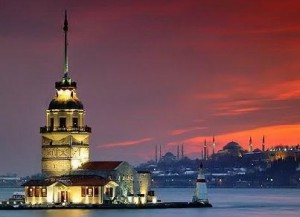 The Maiden’s Tower is located 150-200 meters off the shore of the Salacak district in Üsküdar. Although it is not definite as to when the Maiden’s Tower was built, the tower’s architectural style is said by some sources to be from around 340 BCE. Previous names of the Maiden’s Tower were Damalis and Leandros. Damalis is the name of the wife of the king of Athens,Kharis. When Damalis died, she was buried on the shore, and the name Damalis was given to the Tower. It was also known during Byzantine times as “arcla” which means “a little castle.”
The Maiden’s Tower is located 150-200 meters off the shore of the Salacak district in Üsküdar. Although it is not definite as to when the Maiden’s Tower was built, the tower’s architectural style is said by some sources to be from around 340 BCE. Previous names of the Maiden’s Tower were Damalis and Leandros. Damalis is the name of the wife of the king of Athens,Kharis. When Damalis died, she was buried on the shore, and the name Damalis was given to the Tower. It was also known during Byzantine times as “arcla” which means “a little castle.”
Topkapi Palace With Harem
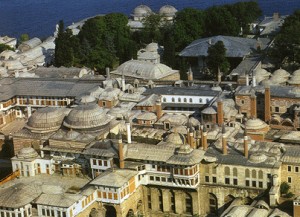 The word harem comes from an Arabic word meaning “forbidden”. Traditionally a harem is the quarters of the women in a household to protect them from male strangers, meaning those who are not related to them. But the harem at Topkapi had so much more to it than that. In 1453, the Ottoman Padishah, Mehmed II captured Constantinople, a great achievement as the Ottomans had been after the beautiful and legendary city for years. He found the ancient Byzantine palaces, such as Blacharnae, in ruins and shambles.
The word harem comes from an Arabic word meaning “forbidden”. Traditionally a harem is the quarters of the women in a household to protect them from male strangers, meaning those who are not related to them. But the harem at Topkapi had so much more to it than that. In 1453, the Ottoman Padishah, Mehmed II captured Constantinople, a great achievement as the Ottomans had been after the beautiful and legendary city for years. He found the ancient Byzantine palaces, such as Blacharnae, in ruins and shambles.
Hippodrome
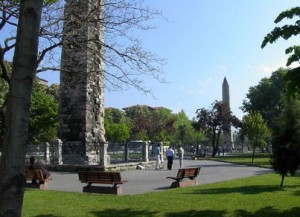 The Hippodrome was built by the Roman Emperor Septimus Severus in 203 AD and Constantine the Great enlarged and adorned it with beautiful works which were brought from different places of the Roman Empire when he chose Byzantium as his new capital. Although there is not much left from the original building except the Egyptian Obelisk, Serpentine and Constantine Columns, according to the excavations carried out, the hippodrome was 117 m / 384 ft wide and 480 m / 1575 ft long with a capacity of 100,000 spectators. Hippodrome was not only used for races but also for public meetings.
The Hippodrome was built by the Roman Emperor Septimus Severus in 203 AD and Constantine the Great enlarged and adorned it with beautiful works which were brought from different places of the Roman Empire when he chose Byzantium as his new capital. Although there is not much left from the original building except the Egyptian Obelisk, Serpentine and Constantine Columns, according to the excavations carried out, the hippodrome was 117 m / 384 ft wide and 480 m / 1575 ft long with a capacity of 100,000 spectators. Hippodrome was not only used for races but also for public meetings.
Dolmabahce Palace
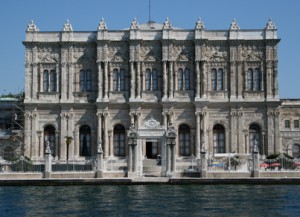 Dolmabahçe Palace was ordered by the Empire’s 31st Sultan, Abdülmecid I, and built between the years 1843 and 1856. Haci Said Aga was responsible for the construction works, while the project was realized by architects Garabet Balyan, his son Nikoghayos Balyan from an renowned Armenian Balyan family of architects in the Ottoman Turkey, and Evanis Kalfa. The construction cost five million Ottoman mecidiye gold coins, the equivalent of 35 tonnes of gold.Fourteen tonnes of gold in the form of gold leaf were used to gild the ceilings of the 45,000 square metre monoblock palace, which stands on an area of 110,000 m².
Dolmabahçe Palace was ordered by the Empire’s 31st Sultan, Abdülmecid I, and built between the years 1843 and 1856. Haci Said Aga was responsible for the construction works, while the project was realized by architects Garabet Balyan, his son Nikoghayos Balyan from an renowned Armenian Balyan family of architects in the Ottoman Turkey, and Evanis Kalfa. The construction cost five million Ottoman mecidiye gold coins, the equivalent of 35 tonnes of gold.Fourteen tonnes of gold in the form of gold leaf were used to gild the ceilings of the 45,000 square metre monoblock palace, which stands on an area of 110,000 m².
Rumeli Castle
 Rumeli fortress was built by the sultan Mehmet the Conqueror in four months only and directly opposite to Anadoluhisari in 1452 in preparation for the final attack on Constantinople, which led to the downfall of the Byzantine Empire. The fortress is located at the narrowest section of the Bosphorus Strait (about 600 meters – 1970 feet). It occupies an area of 60.000 m2 (16 acres), had 4 main and 1 smaller gate, and 3 large and 1 smaller tower. From a small mosque inside, only its minaret survived.
Rumeli fortress was built by the sultan Mehmet the Conqueror in four months only and directly opposite to Anadoluhisari in 1452 in preparation for the final attack on Constantinople, which led to the downfall of the Byzantine Empire. The fortress is located at the narrowest section of the Bosphorus Strait (about 600 meters – 1970 feet). It occupies an area of 60.000 m2 (16 acres), had 4 main and 1 smaller gate, and 3 large and 1 smaller tower. From a small mosque inside, only its minaret survived.
German Fountain
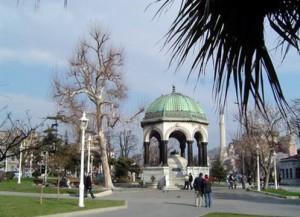 During his reign as German Emperor and King of Prussia, Wilhelm II visited several European and Eastern countries. His trip started in Istanbul, Ottoman Empire on October 18, 1898 during the reign of Abdülhamid II.[2] According to Peter Hopkirk, the visit to Ottoman Empire was an ego trip and also had long-term motivations:[2] The Emperor’s primary motivation for visiting was to construct the Baghdad Railway, which would run from Berlin to the Persian Gulf, and would further connect to British India through Persia.
During his reign as German Emperor and King of Prussia, Wilhelm II visited several European and Eastern countries. His trip started in Istanbul, Ottoman Empire on October 18, 1898 during the reign of Abdülhamid II.[2] According to Peter Hopkirk, the visit to Ottoman Empire was an ego trip and also had long-term motivations:[2] The Emperor’s primary motivation for visiting was to construct the Baghdad Railway, which would run from Berlin to the Persian Gulf, and would further connect to British India through Persia.
Grand Bazaar
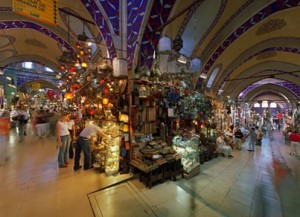 Kapaliçarsi is a great bazaar in Nuri Osmaniye and Beyazid Mosques and Mahmutpasa Bazaar, made up of streets of various shops sheltered by roofs and domes. Though not very regularly shaped, it holds and area of about 31 thousand square meters. It has hundreds of domes which are covered with lead and windows. The nucleus of Kapaliçarsi is a Byzantine building which is today called Old Bedesten. The section of the bazaar where valuables and jewellery are bought and sold was commissioned by Sultan Mehmed the Conqueror and the main great bazaar itself was commissioned during Kanuni Sultan Suleyman, on a wooden basis.
Kapaliçarsi is a great bazaar in Nuri Osmaniye and Beyazid Mosques and Mahmutpasa Bazaar, made up of streets of various shops sheltered by roofs and domes. Though not very regularly shaped, it holds and area of about 31 thousand square meters. It has hundreds of domes which are covered with lead and windows. The nucleus of Kapaliçarsi is a Byzantine building which is today called Old Bedesten. The section of the bazaar where valuables and jewellery are bought and sold was commissioned by Sultan Mehmed the Conqueror and the main great bazaar itself was commissioned during Kanuni Sultan Suleyman, on a wooden basis.